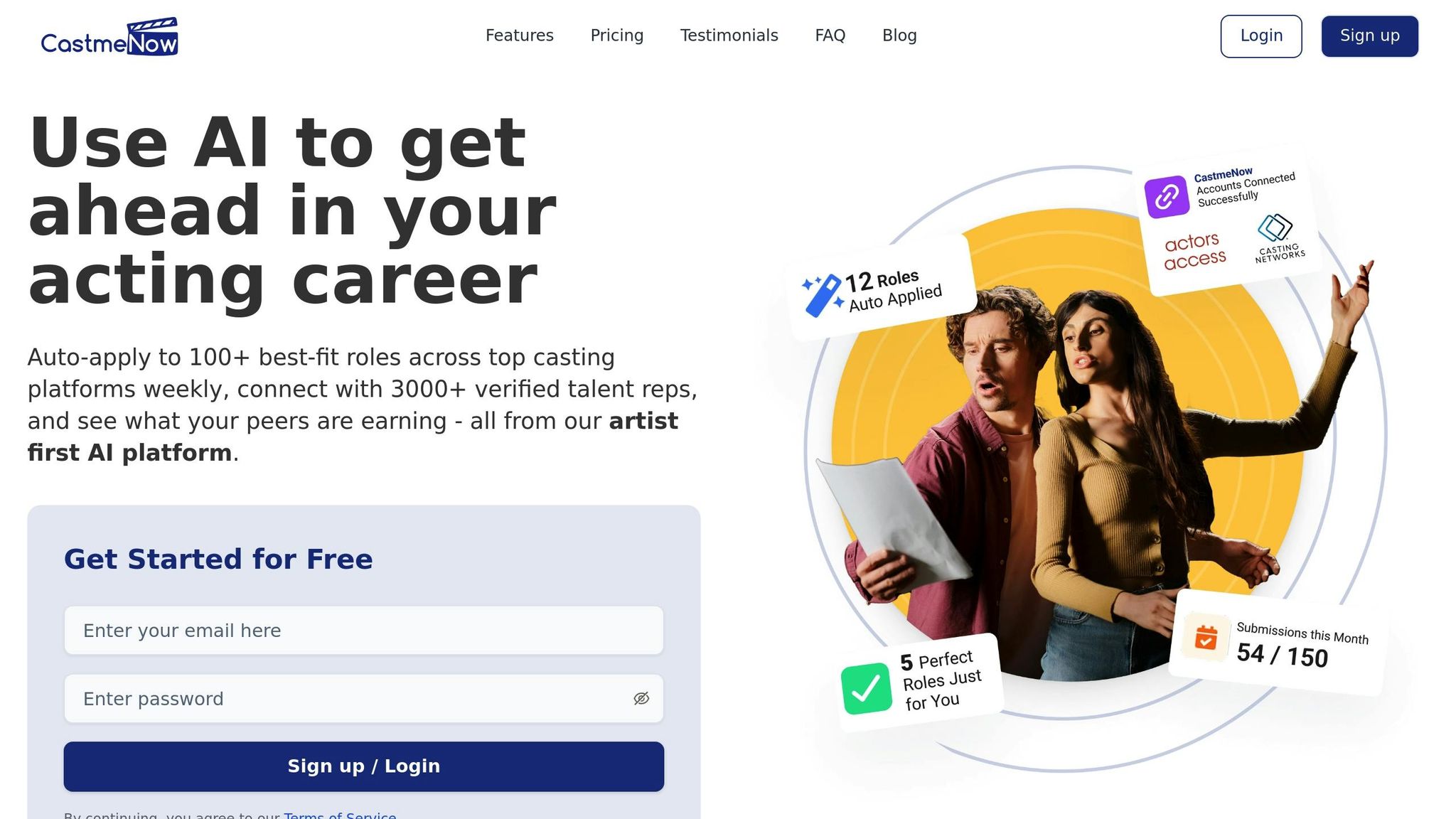How Role Matching Works in Casting Automation
Explore how automation transforms casting by matching actors to roles based on detailed profiles, saving time and enhancing opportunities.

Automation in casting simplifies the process of connecting actors with roles by analyzing detailed profiles and matching them to casting requirements. Instead of actors manually searching for opportunities, systems like CastmeNow handle everything - from scanning listings to submitting applications - all while considering factors like age, skills, and location.
Key takeaways:
- What it does: Matches actors to roles based on profiles and preferences.
- Why it matters: Saves actors time and ensures they never miss relevant opportunities.
- How it works: Uses algorithms to filter and score profiles, continuously scans for updates, and submits applications automatically.
- CastmeNow features: Customizable settings, analytics for career strategy, and affordable subscription plans starting at $3/month.
Automation lets actors focus on their craft while staying competitive in the fast-paced casting world.
Core Technology Behind Role-Matching Algorithms
Data Collection and Actor Profiling
Effective role matching begins with gathering detailed information about actors. Automated systems compile data from various sources to create in-depth profiles, going beyond basic details like demographics. These systems analyze headshots, resumes, and profile information to capture a full picture of each actor.
This process includes collecting physical details such as height, weight, hair color, and eye color, alongside demographics like age, ethnicity, and gender. Beyond appearances, the systems also identify specialized skills - think horseback riding, martial arts, or musical talents - and note professional experience, whether it's in commercials, theater, or film.
Location and availability are also crucial. The system tracks where actors are based, their willingness to travel, and their union status. Whether someone is SAG-AFTRA, non-union, or eligible for union membership directly affects which roles they qualify for. Automated tools flag these distinctions, ensuring that mismatched applications are avoided and time isn’t wasted.
Once these comprehensive profiles are built, the data feeds into algorithms designed to match actors with roles efficiently and effectively.
Algorithmic Role Matching
Role-matching algorithms operate in two stages: filtering and scoring. First, strict filters eliminate profiles that don’t meet the mandatory requirements. For instance, if a role calls for a male actor between 25 and 35 years old, profiles outside that range are instantly excluded.
Next, the system applies a more nuanced approach, assigning compatibility scores based on preferred attributes. These "soft matches" consider factors that aren’t dealbreakers but could make an actor a better fit.
Machine learning plays a key role in refining this process. Over time, the system learns from successful matches and bookings, adjusting its scoring to reflect real-world outcomes. For example, if actors with theater backgrounds consistently land commercial roles requiring strong emotional range, the algorithm will weigh stage experience more heavily for similar roles in the future.
The system also takes career trajectory into account. By analyzing recent bookings, submission history, and stated career goals, it predicts which roles align with an actor’s professional development. This prevents experienced actors from being bombarded with entry-level opportunities and ensures that beginners aren’t overwhelmed with roles beyond their current skill level.
Actors can also influence the process by setting their own priorities. For instance, an actor focused on high-paying jobs will see matches that emphasize compensation, while someone looking to build their reel might get suggestions for roles offering great footage opportunities.
Continuous Scanning and Updates
Role-matching systems don’t take breaks. They operate 24/7, constantly scanning casting platforms for new opportunities. This ensures that actors never miss out on time-sensitive roles, even if they’re unavailable to check listings themselves.
When a new role is posted, the system quickly analyzes its requirements and compares them against existing actor profiles. Qualified actors can have their applications submitted within minutes, keeping them ahead of the competition.
These systems are dynamic, automatically updating actor profiles as new information becomes available. If an actor uploads a new headshot, updates their measurements, or adds a skill to their profile, the system incorporates these changes into future matches.
Timing is also carefully managed. Instead of flooding casting directors with immediate submissions, some algorithms stagger applications to avoid appearing overly automated while still ensuring they’re submitted promptly.
Feedback loops further enhance the process. Every callback or booking provides data that helps fine-tune the algorithm. On the flip side, if certain types of applications consistently go unanswered, the system adjusts to avoid similar mismatches in the future.
The system also adapts to changes in casting requirements. If a casting director modifies role criteria or extends a deadline, the automation detects these updates and resubmits applications from actors who now qualify. This ensures that no opportunity slips through the cracks, even when circumstances change.
Can the Casting Process for Films Be Automated? - The Reality Radar
Step-by-Step: How Automated Role Matching Works
Automated role matching simplifies the casting process by connecting actors with opportunities through three key phases that work together seamlessly.
Setting Up Casting Profiles
The first step is linking your existing casting profiles to an automation platform like CastmeNow. This platform integrates directly with major casting sites like Casting Networks and Actors Access, pulling in your headshots, resume details, physical stats, and skills. This ensures a smooth connection with your current casting accounts.
During this setup, the platform verifies your credentials and creates secure links to your accounts. This one-time setup ensures consistent and accurate submissions across all platforms.
Details like your union status (e.g., SAG-AFTRA, non-union, or union-eligible), location preferences, and availability are also imported. These factors become part of the system's matching criteria, helping it predict roles that suit you best. It even considers your willingness to travel or any scheduling limitations.
Once your profile is synced, you can fine-tune your preferences to ensure the system focuses on roles that align with your career goals.
Defining Preferences and Filters
After integration, you can customize your settings to refine how roles are selected. This step determines which opportunities the system prioritizes.
You can specify role type preferences, such as commercials, film, TV, theater, or voiceover work. You can also set minimum pay requirements, ensuring the system only applies for roles that meet your compensation expectations.
Geographic filters allow you to control where you're willing to work. Whether you prefer local opportunities within 50 miles or are open to major markets like Los Angeles, New York, or Atlanta, the system adapts accordingly.
For career-focused customization, you can set career-stage preferences. For example, if you’re building your reel, you might prioritize roles offering strong footage over higher-paying background work. On the other hand, seasoned actors can exclude entry-level positions that don’t match their experience.
Additionally, scheduling preferences ensure the system only applies for roles that fit your availability. Whether you have date conflicts or prefer specific shooting schedules, the algorithm takes those into account.
Automated Role Applications
Once your profile and preferences are set, the platform takes over, continuously scanning casting platforms around the clock. It identifies roles that meet your criteria and submits your application within minutes, giving you a competitive edge.
When a role matches your settings, the system automatically submits your application using your connected profile. This happens even if you’re unavailable, ensuring you never miss out on time-sensitive opportunities.
| Manual Applications | Automated Applications |
|---|---|
| Requires daily platform checks | Monitors casting platforms 24/7 |
| 5–10 minutes per application | Submits instantly |
| Risk of missing urgent roles | Applications sent within minutes |
| Limited by your schedule | Operates continuously |
| Prone to human error | Consistent and accurate submissions |
| 10–20 applications per day max | Unlimited daily applications possible |
CastmeNow offers two plans to suit your needs: the Basic Plan (up to 10 automated applications daily for $3/month) and the Unlimited Plan (unlimited applications for $8/month). Both plans include core automation features, while the Unlimited Plan adds advanced analytics and enhanced matching capabilities.
The system also tracks all applications, providing feedback on submission success rates. This automated process takes the traditionally time-consuming task of role applications off your plate, allowing you to focus on auditions, training, and honing your craft.
Key Benefits and Considerations for Actors
Automated role matching is changing the game for actors, offering valuable perks while also requiring attention to critical details that can influence long-term success.
Time Savings and More Opportunities
One of the biggest advantages of automation is the time it saves. Instead of spending hours on repetitive applications, you can focus on honing your craft. Meanwhile, the system works non-stop, capturing casting calls as they appear. This constant monitoring increases your chances of being seen by casting directors across multiple platforms, ensuring you don’t miss out on time-sensitive opportunities.
Protecting Your Data and Staying in Control
Your personal and professional information is incredibly important, and keeping it safe is a top priority. CastmeNow addresses these concerns with secure integration methods. It connects directly to your existing Casting Networks and Actors Access accounts without storing your login details. Using encrypted connections and standard security measures, it ensures your data stays protected. On top of that, the platform provides transparent tracking of matches, submission times, and feedback, so you can see how well the system is working for you. Best of all, you retain full ownership of your data. You can update your profiles, tweak preferences, or disconnect from the automation whenever you like.
Keeping Profiles Current to Stay Competitive
Automation works best when your profiles are up to date. Regularly refreshing your headshots, skills, and availability ensures the system matches you with roles that align with your current attributes and talents. This not only reduces mismatches but also presents you as a polished and professional candidate. In a fast-moving casting world, accurate profiles help casting directors quickly see why you’re a great fit for their projects. Staying current gives you an edge and keeps you in the running for the best opportunities.
CastmeNow: Features That Improve Automated Role Matching

CastmeNow combines smart automation with an intuitive design, making it simpler for actors to discover and apply for roles that truly fit their profiles - without the usual headaches.
Automated Role Applications and Smart Matching
With CastmeNow's automated role application system, opportunities don’t slip through the cracks. The platform works 24/7, scanning for roles that meet your criteria and submitting applications as soon as new matches are found.
The advanced matching algorithm takes things a step further. It doesn’t just rely on simple keyword matching. Instead, it dives deep into your profile, analyzing details like your physical attributes, skills, experience, and location preferences. These are then cross-referenced with casting requirements, ensuring you’re applying to roles that align with your qualifications and career aspirations.
What sets this system apart is the preference-guided selection process. You control the parameters - role types, pay ranges, travel requirements, and preferred genres. The system filters opportunities based on these preferences, saving you from wasting time on irrelevant roles. This targeted approach not only streamlines the process but also boosts your chances of landing callbacks by focusing on roles that genuinely fit your goals.
Analytics and Insights for Career Strategy
CastmeNow doesn’t stop at applications - it helps you strategize your career. The platform provides performance analytics, allowing you to track your application rates, responses, and trends. You can quickly spot which types of roles attract the most interest from casting directors and use that data to refine your approach.
The tracking feature keeps you informed about every action the system takes on your behalf. From submitted applications to matched roles and performance metrics, you’ll have a clear picture of how your profile is performing. This transparency gives you the tools to adjust your preferences and improve your outcomes.
Even more, these insights can uncover patterns in your casting journey. For example, you might notice that certain skills or attributes are in high demand or find that specific casting networks yield better responses. Armed with this knowledge, you can make smarter decisions about updating your profile, developing new skills, or shifting your focus to more promising opportunities.
Flexible Subscription Plans and Free Trial
To complement its advanced features, CastmeNow offers subscription plans designed to fit different career stages.
- The Basic Plan costs $3/month and allows up to 10 role applications per day. It’s perfect for actors looking to test the platform’s automation features.
- The Unlimited Plan is $8/month and removes daily application limits. It also unlocks over 25 automation and analytics tools, along with advanced role matching for better results.
Both plans include a 30-day free trial, with no credit card required. This trial gives you full access to every feature, letting you experience the platform’s benefits firsthand before committing to a subscription.
The pricing structure ensures accessibility for actors at any stage of their careers. Whether you’re just starting out or juggling multiple opportunities, there’s a plan that fits your budget and needs. Plus, with the option to switch plans or cancel anytime, you can adapt your subscription as your career progresses.
Conclusion: Using Automation for a Better Acting Career
Automation has reshaped the acting world, allowing performers to shift their energy from tedious administrative tasks to honing their craft. Role-matching tools powered by AI are at the heart of this transformation, offering actors a smarter and faster way to find opportunities that align with their unique strengths.
These systems use AI to analyze elements like vocal tone, facial expressions, and skill sets to deliver highly relevant matches. This means actors are more likely to land auditions that truly suit their abilities. What once took hours - or even days - of manual effort now takes mere minutes, thanks to platforms like CastmeNow, which works seamlessly with major casting networks around the clock. Its advanced algorithms go beyond surface-level demographics, factoring in career aspirations and genre preferences to deliver tailored matches.
But the benefits don’t stop there. Automation also provides actors with actionable insights. By tracking which roles generate the most responses and identifying trends in casting demands, actors can fine-tune their profiles and strategies. Whether it’s uploading fresh headshots or updating skill assessments, keeping profiles current ensures these tools deliver the best results.
Another game-changing aspect of AI-driven casting is its ability to minimize human bias. By focusing purely on qualifications and role fit, these systems promote fairer, more consistent evaluations. This levels the playing field, allowing talent to shine based on merit rather than subjective judgment.
For actors curious about trying this out, CastmeNow offers plans starting at just $3 per month, with a free 30-day trial that doesn’t require a credit card. It’s an easy, low-risk way to explore how automation can fit into their career journey.
As the acting industry continues to evolve, one thing is certain: automation empowers actors to focus on what truly matters - audition preparation, skill-building, and delivering their best performances. By taking the hassle out of opportunity discovery, these tools ensure actors can dedicate more time to their art.
FAQs
How does CastmeNow protect my personal data during the role-matching process?
CastmeNow takes your data security and privacy seriously. It uses secure connections to link with casting profiles, ensuring your personal information stays protected during automated submissions.
The platform also offers customizable privacy settings, allowing you to decide what details you want to share. On top of that, CastmeNow follows strict data protection protocols to keep your information safe from unauthorized access. With a combination of advanced security measures and easy-to-use privacy controls, CastmeNow delivers a safe and hassle-free experience for actors.
Can I set specific preferences for role matching on CastmeNow to align with my career goals?
With CastmeNow, you can fine-tune your role-matching criteria to match your specific career goals and preferences. By adjusting settings like location, role type, and other important factors, the platform connects you with opportunities that truly align with what you're looking for. This tailored system not only saves you time but also keeps your attention on the roles that are most relevant to your ambitions.
How does CastmeNow's machine learning algorithm make role matching more accurate over time?
CastmeNow uses a machine learning algorithm that gets smarter with every piece of new data it processes. By studying past successful matches, it identifies trends and fine-tunes its predictions, making it better at pairing actor profiles with casting needs.
Over time, this ongoing learning process sharpens the system's accuracy, ensuring actors are matched with roles that genuinely suit their abilities, experience, and personal preferences. The end result? A more streamlined casting process that saves actors both time and energy while boosting their opportunities to land roles that are the perfect fit.

